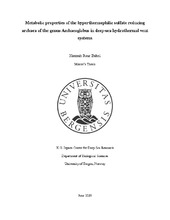| dc.description.abstract | Along the mid-ocean ridge system, super-heated fluids rich in metal sulfides expel out of the ocean floor, precipitating sulfides and forming black smoker chimneys. The precipitated sulfide forms the chimney wall and the fluids abundant in reductive minerals provide the structure, shelter, and energy sources needed for chemosynthetic primary production. The fluids of up to 350 °C and the seawater of -2 °C form a steep temperature gradient within the wall. Likewise, the composition of the hydrothermal vent fluids versus the seawater form steep nutrient and oxygen gradients for different niches of microbes to live, including sulfate reducing prokaryotes (SRPs). In the first part of this study, the rates of sulfate reduction from hydrothermal vents samples were measured to quantify the role of these organisms in their ecosystem. One type of SRP is the hyperthermophilic sulfate reducing archaea from the genus Archaeoglobus. These organisms reduce sulfate, as well as thiosulfate and sulfite, into hydrogen sulfide through the dissimilatory sulfate reduction (DSR) pathway. Proteins from a putative lactate dehydrogenase from Archaeoglobus fulgidus previously hypothesized to be an electron supply needed for the second step of the DSR pathway were further researched in the second part of this study. Minute amounts of sulfate reduction was measured within the chimney wall of a black smoker located at Loki’s Castle Vent Field (LCVF) and despite the correlating community analysis lacking evidence of the existence Archaeoglobus, the presence of the sulfate reducing bacteria thermodesulfobacteriaceae and Desulfohalobiaceae were found in low relative abundance. Genes encoding a putative lactate dehydrogenase (LDH) complex and other associated proteins from Archaeoglobus fulgidus were cloned into E. coli. This LDH complex may play an important role in providing electrons to the DSR pathway within A. fulgidus. Three of these proteins were successfully expressed and purified. Of the proteins purified, the glycolate oxidase subunit was tested for secondary structure and melting temperature using circular dichroism, which gave further evidence to the protein being a of hyperthermophilic nature. | en_US |
